八年级英语下册Unit 9 Have you ever been to a museum Section A(1a-2d)(共27张PPT,内嵌音频)
文档属性
| 名称 | 八年级英语下册Unit 9 Have you ever been to a museum Section A(1a-2d)(共27张PPT,内嵌音频) |  | |
| 格式 | pptx | ||
| 文件大小 | 14.7MB | ||
| 资源类型 | 教案 | ||
| 版本资源 | 人教新目标(Go for it)版 | ||
| 科目 | 英语 | ||
| 更新时间 | 2025-02-08 17:48:10 | ||
图片预览

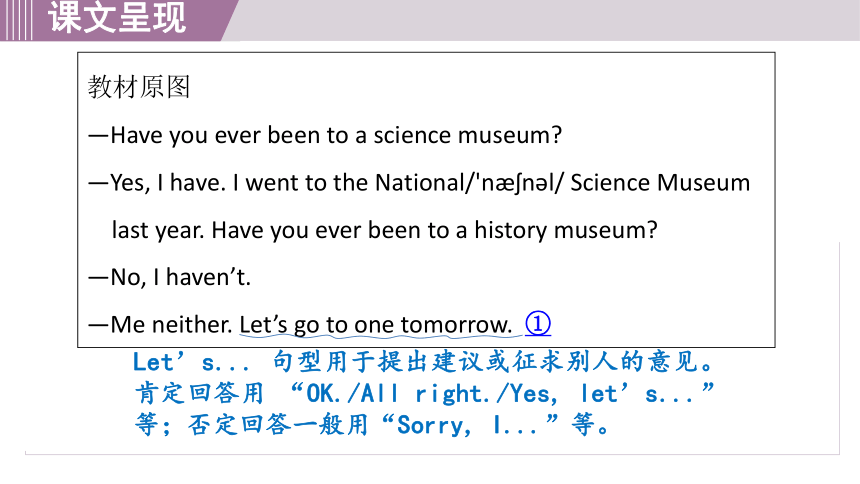
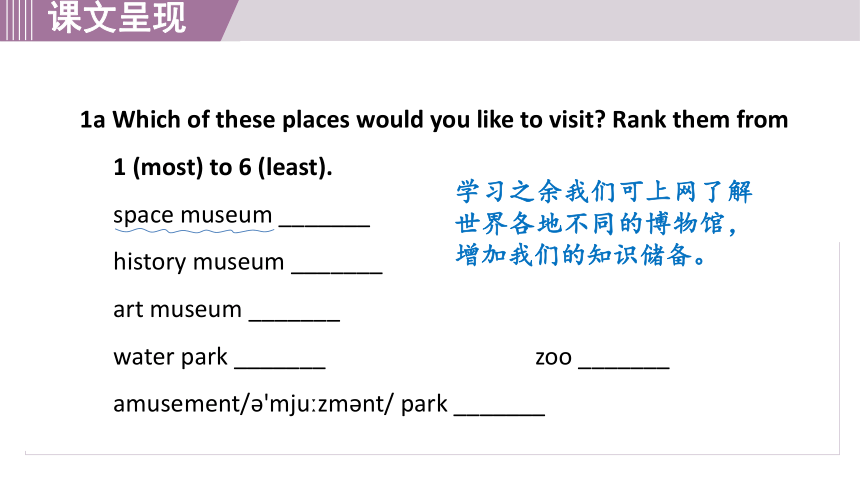
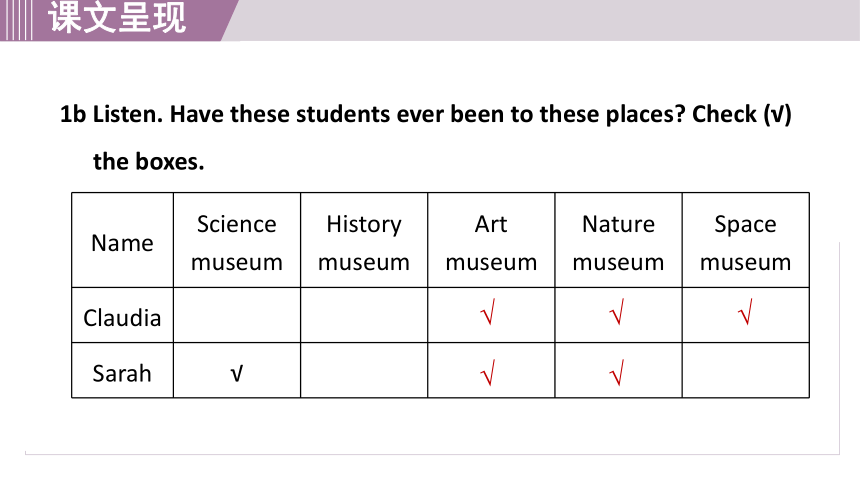
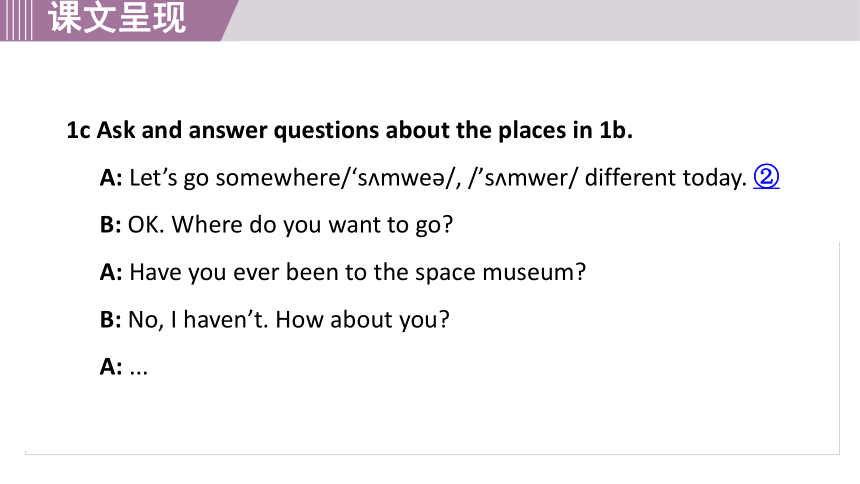
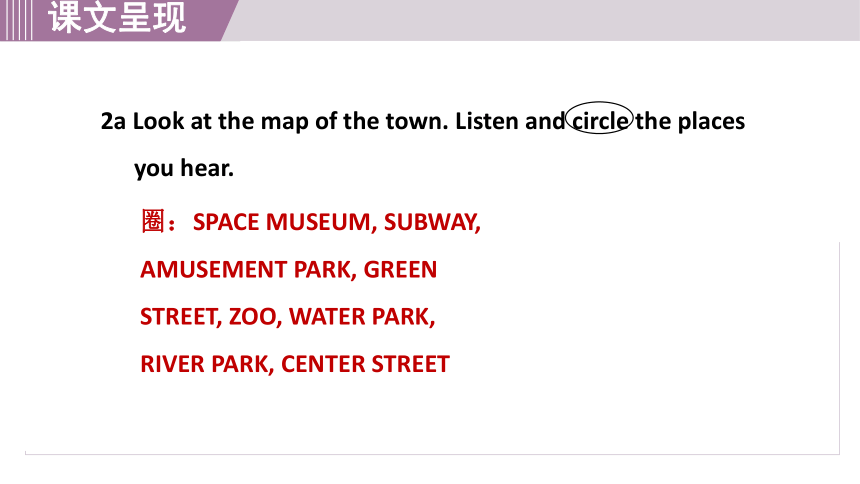
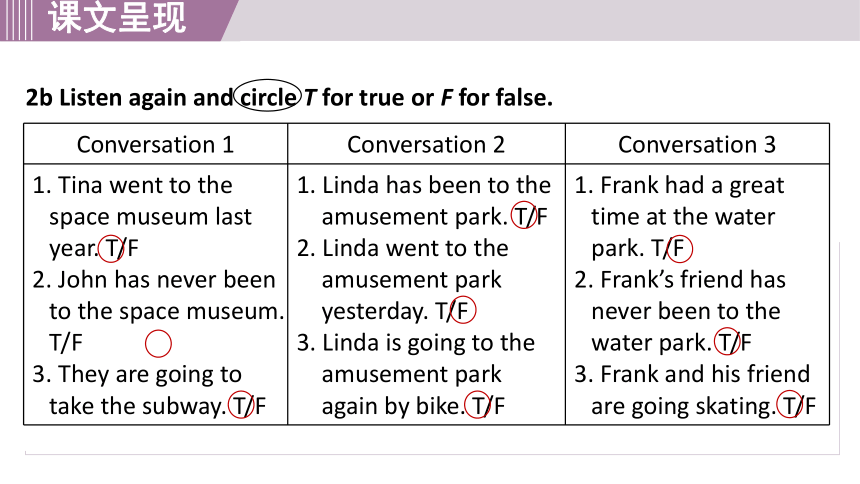
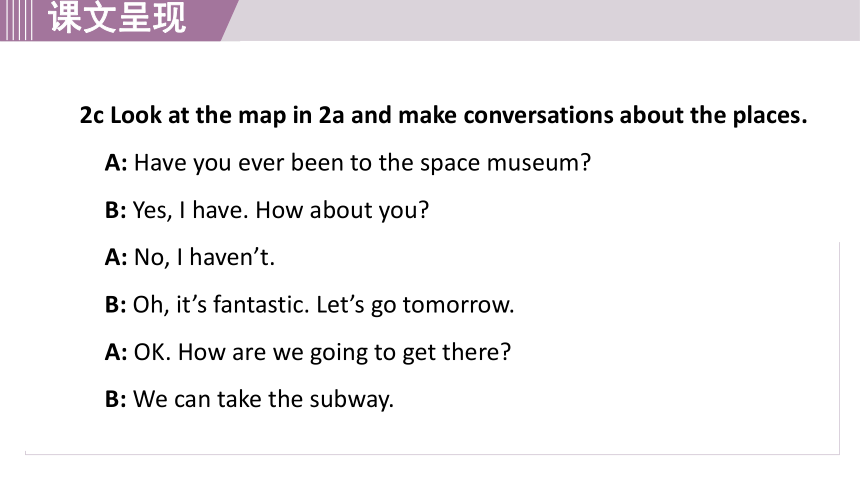
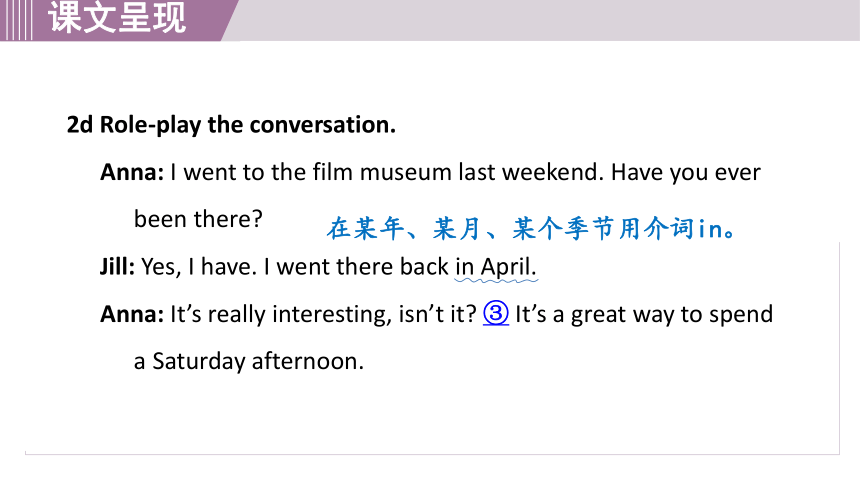
文档简介
(共27张PPT)
Period 1 Section A(1a-2d)
Unit 9 Have you ever been to a museum
教材原图
—Have you ever been to a science museum
—Yes, I have. I went to the National/'n n l/ Science Museum last year. Have you ever been to a history museum
—No, I haven’t.
—Me neither. Let’s go to one tomorrow. ①
Let’s... 句型用于提出建议或征求别人的意见。肯定回答用 “OK./All right./Yes, let’s...”等;否定回答一般用“Sorry, I...”等。
1a Which of these places would you like to visit Rank them from 1 (most) to 6 (least).
space museum _______
history museum _______
art museum _______
water park _______ zoo _______
amusement/ 'mju zm nt/ park _______
学习之余我们可上网了解世界各地不同的博物馆,增加我们的知识储备。
1b Listen. Have these students ever been to these places Check (√) the boxes.
Name Science museum History museum Art museum Nature museum Space
museum
Claudia
Sarah √
√
√
√
√
√
1c Ask and answer questions about the places in 1b.
A: Let’s go somewhere/‘s mwe /, /’s mwer/ different today. ②
B: OK. Where do you want to go
A: Have you ever been to the space museum
B: No, I haven’t. How about you
A: ...
圈:SPACE MUSEUM, SUBWAY,
AMUSEMENT PARK, GREEN
STREET, ZOO, WATER PARK,
RIVER PARK, CENTER STREET
2a Look at the map of the town. Listen and circle the places you hear.
2b Listen again and circle T for true or F for false.
Conversation 1 Conversation 2 Conversation 3
1. Tina went to the space museum last year. T/F 2. John has never been to the space museum. T/F 3. They are going to take the subway. T/F 1. Linda has been to the amusement park. T/F 2. Linda went to the amusement park yesterday. T/F 3. Linda is going to the amusement park again by bike. T/F 1. Frank had a great time at the water park. T/F
2. Frank’s friend has never been to the water park. T/F
3. Frank and his friend are going skating. T/F
2c Look at the map in 2a and make conversations about the places.
A: Have you ever been to the space museum
B: Yes, I have. How about you
A: No, I haven’t.
B: Oh, it’s fantastic. Let’s go tomorrow.
A: OK. How are we going to get there
B: We can take the subway.
2d Role-play the conversation.
Anna: I went to the film museum last weekend. Have you ever been there
Jill: Yes, I have. I went there back in April.
Anna: It’s really interesting, isn’t it ③ It’s a great way to spend a Saturday afternoon.
在某年、某月、某个季节用介词in。
Jill: Yes, I love all the old movie cameras /'k m r z/ there. I learned about the inventions/ n'ven nz/ that led to color movies, too. ④
Anna: So, what did you do on the weekend
learn about与learn of同义,后面接所了解的具体内容,意为“了解;获知;得知”。
Jill: I camped in the mountains with some friends. We put up a tent and cooked outside.
Anna: That sounds fun. I’ve never been camping.
Jill: You should try it!
本句时态为现在完成进行时,其结构为“主语+ have/has been +动词的现在分词.”,表示某动作从过去某个时间开始,一直延续到现在,并且还有可能持续下去。常与“for+时间段”或“since +时间点”连用。
1 Let’s go to one tomorrow.
(高频) one 作代词的用法
辨析:one,it 与that
one 替代可数名词单数,表示泛指,代替前面提到的同类人或事物中的一个,表示同类异物。替代可数名词复数用ones。也可单独使用,前面也可以用“冠词+ 形容词”或this , that, which, either等修饰。
it 既可替代可数名词单数,也可替代不可数名词,特指前面提到过的同一事物,表示同类同物。
that 替代可数名词单数或不可数名词,常用于有比较含义的句子中,其复数形式为those。
The hat is not the right size for me. I’d like a smaller one.
这顶帽子的尺寸不适合我。我想要一顶更小一点的。
I bought a book for you. I hope you like it.
我给你买了一本书,希望你喜欢它。
The watch you bought is cheaper than that I bought.
你买的手表比我买的更便宜。
泛指一顶更小的帽子。
特指前面提到的书。
指前面提到的手表,
但不是同一个。
速记小法
同类同物it 替,可单不可两相宜,
同类异物就用one,仔细理解认真记。
谚语
A man can do no more than he can.
凡事都应量力而行。
考题1: [黄石] Sam finds sweeping robots useful, and he plans to buy _______ for his grandma.
A. it B. one C. this D. that
B
返回
【点拨】本句指的是扫地机器指前面提到的手表,但不是同一个。人中的一个,不一定就是前面提到的扫地机器人,即同类异物,所以用one 来代替。
2 Let’s go somewhere different today.
(重点)somewhere /'s mwe / , /'s mwer/ adv. 在某处;到某处
somewhere为不定副词,常用于肯定句和表示委婉语气的问句中。
敲黑板
(1)somewhere 通常用于肯定句中,在否定句或疑问句中用anywhere。(2)形容词修饰不定副词要后置。
I didn’t go anywhere during my last holiday. I’m thinking about going somewhere nice after this exam. Life is full of beauty everywhere and we should enjoy it. However, because of the typhoon, we have nowhere to go at present. 我上一个假期没有去任何地方。我想在这次考试后去一个好地方。生活处处都充满了美,我们应该享受它。然而,因为台风,我们目前无处可去。
拓展:somewhere 还可以作代词,意为“某个地方;某处”。
The kids want to find somewhere to practise their music.
孩子们想找个地方去练习音乐。
其他常见的不定副词:
everywhere 处处;到处(相当于here and there)
nowhere 哪里都不(表示否定意义)
anywhere 在任何地方(用于否定句或疑问句中)
考题2: I’d like to go ________ during my summer holiday.
A. nowhere interesting
B. interesting anywhere
C. somewhere interesting
D. interesting somewhere
C
返回
3 It’s really interesting, isn’t it
(高频)反意疑问句
反意疑问句又称“附加疑问句”,是指在陈述句后附加一个简短问句,用于征询肯定或否定的意见,或者希望陈述句所说的内容得到证实。
—She is still a student, isn’t she 她还是个学生,不是吗?
—Yes, she is./No, she isn’t. 是的,她是。/ 不,她不是。
—He hasn’t been to Qingdao, has he 他没有去过青岛,是吗?
—Yes, he has./ No, he hasn’t. 不,他去过。/ 是,他没去过。
反意疑问句的两种形式及答语:
(1) 肯定陈述句+ 否定附加问句(前肯后否)
(2) 否定陈述句+ 肯定附加问句(前否后肯)
(3) 答语:肯定事实用yes,否定事实用no,注意回答一致。在“前否后肯”的反意疑问句答语中,yes 译为“不”,no译为“是”。
拓展: (1)当陈述部分含有no, nothing, nobody, never, few, little, seldom, hardly 等表示否定含义的词时,附加的简短问句要用肯定形式。
Tom hardly writes to you, does he 汤姆几乎不给你写信,对吗
(2)当陈述部分用there be 结构时,附加的简短问句也要用there be形式。
There is nothing in the box, is there 盒子里什么也没有,是吗?
敲黑板
反意疑问句前后两部分的主语在人称和数方面要保持一致(且附加问句要用对应的人称代词),be 动词、助动词和情态动词也要与主语在人称和数方面保持一致。
考题3: —The old man never feels lonely, ________
—No, because he has many friends.
A.does he B.won’t he C.doesn’t he
A
返回
4 I learned about the inventions...
(重点) invention / n'ven n/ n. 发明;发明物
The invention of porcelain has greatly influenced the world.
瓷器的发明极大地影响了世界。
敲黑板
意为“发明”时,是不可数名词;
意为“发明物”时,是可数名词。
Edison invented a lot of things. He is a great inventor and he is famous for his inventions. 爱迪生发明了许多东西。他是一位伟大的发明家,他因他的发明物而闻名。
谚语记单词
Necessity is the mother
of invention.
需要是发明之母。
invention 的词形变化:
invent v. 发明
inventor n. 发明家
考题4: ChatGPT is one of the most amazing ____________(invent). I think it will change the world.
inventions
返回
Period 1 Section A(1a-2d)
Unit 9 Have you ever been to a museum
教材原图
—Have you ever been to a science museum
—Yes, I have. I went to the National/'n n l/ Science Museum last year. Have you ever been to a history museum
—No, I haven’t.
—Me neither. Let’s go to one tomorrow. ①
Let’s... 句型用于提出建议或征求别人的意见。肯定回答用 “OK./All right./Yes, let’s...”等;否定回答一般用“Sorry, I...”等。
1a Which of these places would you like to visit Rank them from 1 (most) to 6 (least).
space museum _______
history museum _______
art museum _______
water park _______ zoo _______
amusement/ 'mju zm nt/ park _______
学习之余我们可上网了解世界各地不同的博物馆,增加我们的知识储备。
1b Listen. Have these students ever been to these places Check (√) the boxes.
Name Science museum History museum Art museum Nature museum Space
museum
Claudia
Sarah √
√
√
√
√
√
1c Ask and answer questions about the places in 1b.
A: Let’s go somewhere/‘s mwe /, /’s mwer/ different today. ②
B: OK. Where do you want to go
A: Have you ever been to the space museum
B: No, I haven’t. How about you
A: ...
圈:SPACE MUSEUM, SUBWAY,
AMUSEMENT PARK, GREEN
STREET, ZOO, WATER PARK,
RIVER PARK, CENTER STREET
2a Look at the map of the town. Listen and circle the places you hear.
2b Listen again and circle T for true or F for false.
Conversation 1 Conversation 2 Conversation 3
1. Tina went to the space museum last year. T/F 2. John has never been to the space museum. T/F 3. They are going to take the subway. T/F 1. Linda has been to the amusement park. T/F 2. Linda went to the amusement park yesterday. T/F 3. Linda is going to the amusement park again by bike. T/F 1. Frank had a great time at the water park. T/F
2. Frank’s friend has never been to the water park. T/F
3. Frank and his friend are going skating. T/F
2c Look at the map in 2a and make conversations about the places.
A: Have you ever been to the space museum
B: Yes, I have. How about you
A: No, I haven’t.
B: Oh, it’s fantastic. Let’s go tomorrow.
A: OK. How are we going to get there
B: We can take the subway.
2d Role-play the conversation.
Anna: I went to the film museum last weekend. Have you ever been there
Jill: Yes, I have. I went there back in April.
Anna: It’s really interesting, isn’t it ③ It’s a great way to spend a Saturday afternoon.
在某年、某月、某个季节用介词in。
Jill: Yes, I love all the old movie cameras /'k m r z/ there. I learned about the inventions/ n'ven nz/ that led to color movies, too. ④
Anna: So, what did you do on the weekend
learn about与learn of同义,后面接所了解的具体内容,意为“了解;获知;得知”。
Jill: I camped in the mountains with some friends. We put up a tent and cooked outside.
Anna: That sounds fun. I’ve never been camping.
Jill: You should try it!
本句时态为现在完成进行时,其结构为“主语+ have/has been +动词的现在分词.”,表示某动作从过去某个时间开始,一直延续到现在,并且还有可能持续下去。常与“for+时间段”或“since +时间点”连用。
1 Let’s go to one tomorrow.
(高频) one 作代词的用法
辨析:one,it 与that
one 替代可数名词单数,表示泛指,代替前面提到的同类人或事物中的一个,表示同类异物。替代可数名词复数用ones。也可单独使用,前面也可以用“冠词+ 形容词”或this , that, which, either等修饰。
it 既可替代可数名词单数,也可替代不可数名词,特指前面提到过的同一事物,表示同类同物。
that 替代可数名词单数或不可数名词,常用于有比较含义的句子中,其复数形式为those。
The hat is not the right size for me. I’d like a smaller one.
这顶帽子的尺寸不适合我。我想要一顶更小一点的。
I bought a book for you. I hope you like it.
我给你买了一本书,希望你喜欢它。
The watch you bought is cheaper than that I bought.
你买的手表比我买的更便宜。
泛指一顶更小的帽子。
特指前面提到的书。
指前面提到的手表,
但不是同一个。
速记小法
同类同物it 替,可单不可两相宜,
同类异物就用one,仔细理解认真记。
谚语
A man can do no more than he can.
凡事都应量力而行。
考题1: [黄石] Sam finds sweeping robots useful, and he plans to buy _______ for his grandma.
A. it B. one C. this D. that
B
返回
【点拨】本句指的是扫地机器指前面提到的手表,但不是同一个。人中的一个,不一定就是前面提到的扫地机器人,即同类异物,所以用one 来代替。
2 Let’s go somewhere different today.
(重点)somewhere /'s mwe / , /'s mwer/ adv. 在某处;到某处
somewhere为不定副词,常用于肯定句和表示委婉语气的问句中。
敲黑板
(1)somewhere 通常用于肯定句中,在否定句或疑问句中用anywhere。(2)形容词修饰不定副词要后置。
I didn’t go anywhere during my last holiday. I’m thinking about going somewhere nice after this exam. Life is full of beauty everywhere and we should enjoy it. However, because of the typhoon, we have nowhere to go at present. 我上一个假期没有去任何地方。我想在这次考试后去一个好地方。生活处处都充满了美,我们应该享受它。然而,因为台风,我们目前无处可去。
拓展:somewhere 还可以作代词,意为“某个地方;某处”。
The kids want to find somewhere to practise their music.
孩子们想找个地方去练习音乐。
其他常见的不定副词:
everywhere 处处;到处(相当于here and there)
nowhere 哪里都不(表示否定意义)
anywhere 在任何地方(用于否定句或疑问句中)
考题2: I’d like to go ________ during my summer holiday.
A. nowhere interesting
B. interesting anywhere
C. somewhere interesting
D. interesting somewhere
C
返回
3 It’s really interesting, isn’t it
(高频)反意疑问句
反意疑问句又称“附加疑问句”,是指在陈述句后附加一个简短问句,用于征询肯定或否定的意见,或者希望陈述句所说的内容得到证实。
—She is still a student, isn’t she 她还是个学生,不是吗?
—Yes, she is./No, she isn’t. 是的,她是。/ 不,她不是。
—He hasn’t been to Qingdao, has he 他没有去过青岛,是吗?
—Yes, he has./ No, he hasn’t. 不,他去过。/ 是,他没去过。
反意疑问句的两种形式及答语:
(1) 肯定陈述句+ 否定附加问句(前肯后否)
(2) 否定陈述句+ 肯定附加问句(前否后肯)
(3) 答语:肯定事实用yes,否定事实用no,注意回答一致。在“前否后肯”的反意疑问句答语中,yes 译为“不”,no译为“是”。
拓展: (1)当陈述部分含有no, nothing, nobody, never, few, little, seldom, hardly 等表示否定含义的词时,附加的简短问句要用肯定形式。
Tom hardly writes to you, does he 汤姆几乎不给你写信,对吗
(2)当陈述部分用there be 结构时,附加的简短问句也要用there be形式。
There is nothing in the box, is there 盒子里什么也没有,是吗?
敲黑板
反意疑问句前后两部分的主语在人称和数方面要保持一致(且附加问句要用对应的人称代词),be 动词、助动词和情态动词也要与主语在人称和数方面保持一致。
考题3: —The old man never feels lonely, ________
—No, because he has many friends.
A.does he B.won’t he C.doesn’t he
A
返回
4 I learned about the inventions...
(重点) invention / n'ven n/ n. 发明;发明物
The invention of porcelain has greatly influenced the world.
瓷器的发明极大地影响了世界。
敲黑板
意为“发明”时,是不可数名词;
意为“发明物”时,是可数名词。
Edison invented a lot of things. He is a great inventor and he is famous for his inventions. 爱迪生发明了许多东西。他是一位伟大的发明家,他因他的发明物而闻名。
谚语记单词
Necessity is the mother
of invention.
需要是发明之母。
invention 的词形变化:
invent v. 发明
inventor n. 发明家
考题4: ChatGPT is one of the most amazing ____________(invent). I think it will change the world.
inventions
返回
同课章节目录
- Unit 1 What's the matter?
- Section A
- Section B
- Unit 2 I'll help to clean up the city parks.
- Section A
- Section B
- Unit 3 Could you please clean your room?
- Section A
- Section B
- Unit 4 Why don't you talk to your parents?
- Section A
- Section B
- Unit 5 What were you doing when the rainstorm came
- Section A
- Section B
- Review of Units 1-5
- Unit 6 An old man tried to move the mountains.
- Section A
- Section B
- Unit 7 What's the highest mountain in the world?
- Section A
- Section B
- Unit 8 Have you read Treasure Island yet?
- Section A
- Section B
- Unit 9 Have you ever been to a museum?
- Section A
- Section B
- Unit 10 I've had this bike for three years.
- Section A
- Section B
